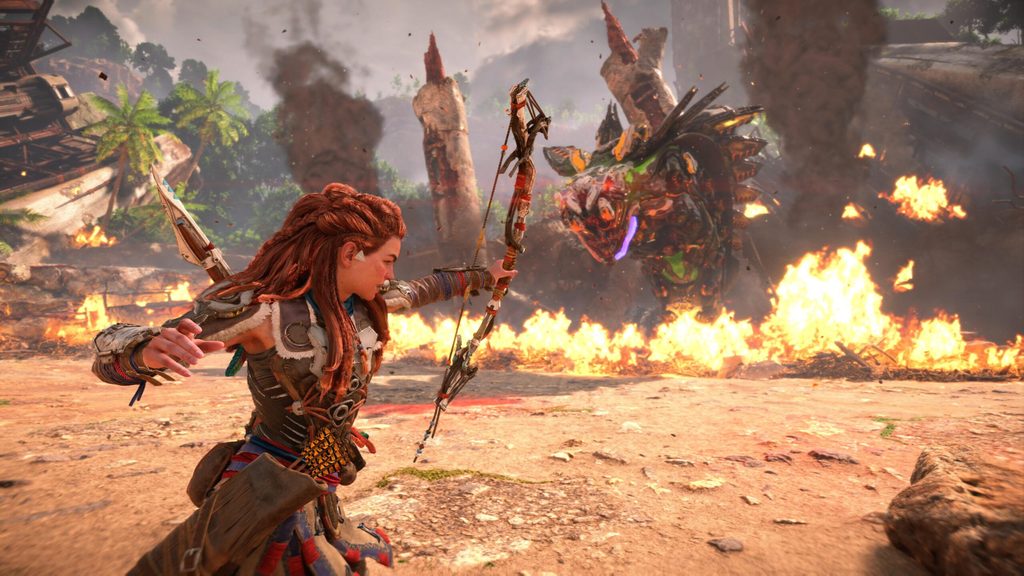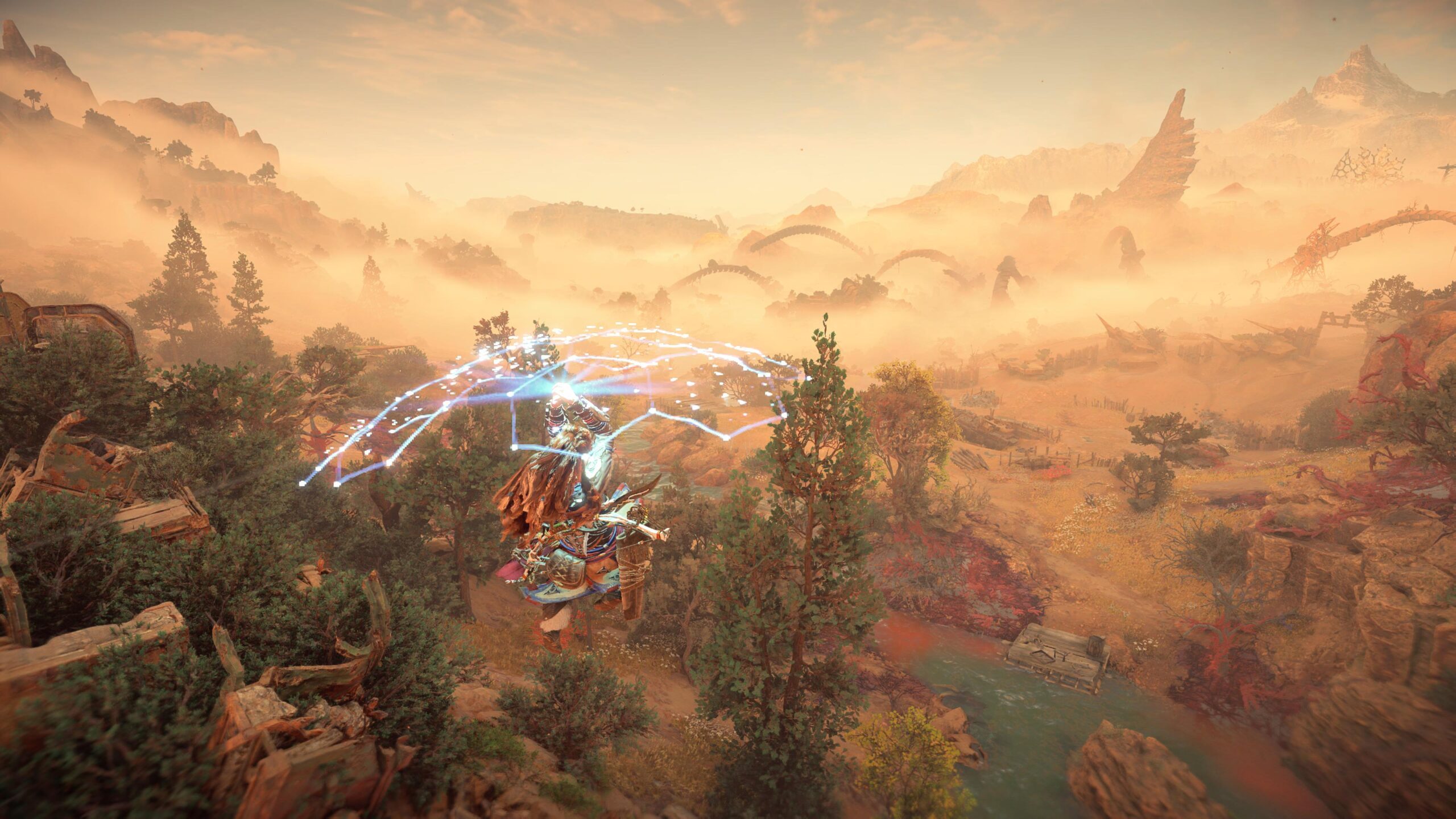SUMMARY
This is AI generated summarization, which may have errors. For context, always refer to the full article.

(Disclosure: Horizon Forbidden West was reviewed on PS5 with a publisher-provided code. The game comes out on February 18.)
To say that expectations are high for Horizon Forbidden West is a bit of an understatement. It’s a pillar release for what is likely to be a banner year for Sony’s PlayStation division, with Gran Turismo 7 and God of War Ragnarök also on the horizon (pun intended). It’s also the sequel to what is regarded as one of the best games of the previous generation. So a lot is riding on Dutch developer Guerilla Games to deliver on the next chapter of their post-apocalyptic epic. And, boy, do they deliver.
Forbidden West builds upon the foundations of Zero Dawn and masterfully expands it in such a way that feels organic (weird word, I know, for a game that’s all about machines). The world is richer. The combat is deeper. The traversal is smoother. And nearly every aspect of the game is crafted with such unwavering confidence that you can overlook whatever tiny cracks there are in between.
Another world-ending threat
Horizon’s sophomore outing picks up six months after the events of the first game. There’s a mysterious world-ending blight infecting the land and it’s up to heroine Aloy to find a cure in the Forbidden West, a dangerous frontier teeming with new hostile forces, both man and machine.
The story benefits from a much faster pace. Whereas Zero Dawn takes its time to get you acquainted with its world, Forbidden West assumes you already know what you’re in for and throws you straight into the fold.
The aforementioned Aloy is no longer the curious and naive outsider from the first game. She’s since grown into a capable machine hunter, who’s both headstrong and reckless. And that growth makes her a much more compelling character, especially now that she knows her true origin and purpose. She’s free to be who she truly is, which in turn gives her heroics more time to shine.

The supporting characters also have more to do here. Some of her companions even join her in certain parts of the game, a welcome change that further hammers home the idea that our heroine is not alone in her struggle to save the planet.
A warning though: This is a direct sequel of Zero Dawn, so if you haven’t played that yet, the story may be a little hard to follow. There’s a Netflix-style video recap of past events when you start the game, but it plays more like a refresher for returning fans than an intro to new ones.
New world, new tools
What carries Horizon’s story are the breathtaking visuals. And it’s not just the graphics that are worthy of praise but also the art direction, the lighting, the animations, and the voice acting, to name a few. They all work harmoniously together in elevating the game’s presentation into a sphere that so few games could match. It’s a true marvel from both an artistic and technical standpoint. So much so that I couldn’t help but stop every few steps to turn my camera in a full circle and admire the visuals.
On PS5, the game has two graphics modes: Favor Performance and Favor Resolution. And from their names alone, you can probably already guess what each mode brings. Both work very well, but I mostly stuck to performance mode for this review. The game gives you the ability to switch between modes on the fly via the options menu. However, the 60fps of the performance mode is so crucial to the tight combat that not even once did I ever consider sacrificing smoother gameplay for a sharper image. But if you prefer pushing the game to 4K resolution, at least you have the option to do so on next-gen hardware.

The only hiccup, if you can call it that, I noticed with the visuals is how the hair physics can get a bit wonky at times. During some cutscenes, you’d occasionally notice clumps of hair flailing around as if they had a life of their own.
Wet and wild
Forbidden West plays almost exactly like Zero Dawn. You explore a vast open world filled with machines to hunt, towns to visit, side quests to tackle, and secret collectibles to uncover. The difference this time around is there’s a lot more verticality, with Aloy now having the ability to dive underwater. And these new locations feel like natural expansions to Horizon’s world by how well they fit into the core gameplay loop.
The underwater locations are almost a second open world in and of themselves. They’re not only expansive but also densely populated with flora and fauna. And they’re no different from the land locales that beautifully contrast the often vibrant hues of nature with the dreary, rust-colored ruins of ravaged human cities.
Mechanically, I like how the game incorporates a lot of what you do on land underwater. Machines have also learned to swim and you can either fight or sneak past them when you’re beneath the surface. Fighting machines underwater can prove to be a tougher experience than on land as Aloy is less agile when she’s swimming. As such, there’s a lot more thought that goes into these encounters. You’ll always be weighing whether to fight or to simply hide and wait.
Not to say that encounters on land don’t get the same love. They’re still very much as exhilarating and as challenging as the first game. The addition of new machines do a lot to make you approach each encounter differently. And combat is deeper and more robust this time around, with Aloy now having access to new tools and abilities. But the game never gives you more than what you need. So even the most seemingly trivial machines can still pose a threat if you’re not careful or strategic, making combat victories feel even more rewarding.
Here, Aloy gets a Pullcaster for exploration, a grapple gun of sorts, which allows her to propel to specific hooking spots and reach otherwise unreachable areas in the map. It’s a nifty tool that opens up new traversal opportunities and similarly helps expand the open world’s verticality. It also helps to improve the climbing mechanics, bringing a greater sense of freedom to how you might navigate through the game’s platforming sections.
It even becomes more liberating when you use the Pullcaster in tandem with the Breath of the Wild-esque Shieldwing glider, shown below.

You can, for instance, jump off a perch and soar through the skies with the Shieldwing before pulling yourself to another perch with the Pullcaster. And the transition between using the two tools feels incredibly fluid.
Get sidetracked
But arguably the best part about Forbidden West is the open world itself, which I think is the closest a game has come to creating a fully living ecosystem. The wild machines you encounter in your journey are always in some way reacting to their environment. They scout for predators, scavenge scraps or roam certain parts of the map like it’s their habitat. Sometimes, it’s as though you’re watching a nature documentary, but instead of actual animals, you have their mechanical counterparts. And these minute details are what helps up the immersion. It’s like an illusion that tricks our brains into thinking that the game’s world doesn’t entirely revolve around us and our actions – that “life” goes on regardless of where we are or what we’re doing.
The human towns are also bustling with activity, making them feel alive and lived in. This is where you can shop for new items or upgrade existing ones. It’s also the place where you’ll usually find side quests to pursue. And a lot of them are worth pursuing because they always net useful loot. Some also feature interesting stories that serve as good diversions to Aloy’s journey.
That said, Forbidden West is not exempt from open world fatigue, with it largely sticking to a familiar formula, where you tick off a laundry list of optional tasks in bursts of story content. It still works, I will say that. And the game tries its best to make almost every activity feel worthwhile to the player, which I appreciate. But given its size – the open world is as big as that of the first game’s, if not bigger – I’d understand if someone might just want to rush through the story.
Then again, not many games put this much effort into making the side content feel like it respects players’ time – like they’re not just there to pad out the game’s length. So in that regard, Forbidden West is a notch above other open world games.
The game, for the most part, should feel familiar to those who have played Zero Dawn – sometimes too familiar even. And like that game, this sequel doesn’t do anything to reinvent the genre. So chances are if you didn’t like the first game, there’s not a lot you’ll like here, except maybe the gorgeous visuals.
Still, it can’t be emphasized enough how the talented folks at Guerilla Games didn’t rest on their laurels making Forbidden West, expanding and refining Horizon’s world and gameplay in every way possible. It’s nothing short of impressive how there’s so much attention to detail here given the tremendous scope. There’s also a level of technical polish that I haven’t seen from a major release in quite a while. And even though I don’t think it ever reaches the heights of Sony’s other exclusives like The Last of Us or God of War, this is a game that’s emblematic of the type of quality you come to expect from the company’s first-party offerings, making you proud to own a PlayStation system. – Rappler.com
Add a comment
How does this make you feel?
There are no comments yet. Add your comment to start the conversation.